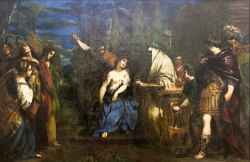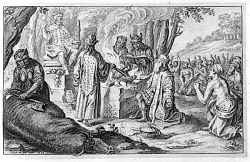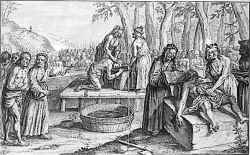Topic: 2. Sacrifice and religion: Comparisons, Antiquarians, Anthropology (16th-18th Century)
Religious sacrifices across various cultures and contexts sparked widespread interest in Early Modern Europe. As Christianity expanded into regions inhabited by "infidels" and "pagans", Europeans encountered a diverse array of sacrificial customs, ranging from the Sati rituals in India to the Aztec sacrifices in the Americas. This cross-cultural exposure captivated a wide audience, including theologians, philosophers, political thinkers, antiquarians, orientalists, missionaries, poets, artists, and even the general public. These encounters broadened the European understanding of sacrifice and led to a critical reassessment of classical and biblical sacrificial rites. This section includes:
- Sources: A selection of early modern printed materials, which include descriptions of the Americas, Asia, and Africa, alongside antiquarian and philological studies on religious sacrifice in classical antiquity and beyond. It also presents early modern works of ethnological observations and the first attempts to compare different sacrificial practices in various traditions and contexts, laying the groundwork for disciplines like the history of religions and anthropology.
- Iconographic Representations: A rich collection of images from the 16th to 18th centuries, illustrating a range of sacrificial rituals and practices as seen in different cultural and geographical contexts.
- Related Bibliography: An extensive bibliography spanning scholarly works from the 19th to 21st centuries, providing contemporary analyses and interpretations of these early studies and observations.
Sacred performances : Islam, sexuality, and sacrifice
New York: Columbia University Press, 1989.
The doctrine of antiquity concerning the most blessed eucharist: plainly shewed, in remarks written, some years since, upon Mr. Johnson's book, of The unbloody sacrifice and now published, on occasion of a book, intituled A plain account, &c. By Clerophilus
London: n. p., 1736.
The sacrifice of Polyxena (1625)
Roma, Musei Capitolini
Giovanni II Bentivoglio and His Family (1488)
Chiesa di San Giacomo Maggiore, Cappella Bentivolgio, Bologna
Iphigenia Treur-Spel
Amsterdam: Nicolaas Biestkens, 1617.
The Iconographies of Sati
in: Sati, the Blessing and the Curse: The Burning of Wives in India, pp. 27-49
Oxford: Oxford University Press, 1994.
Mizbeah olah seu De ara exteriore templi secundi exercitationes philologicae. Ubi ea ex auctoribus Hebraeis exponitur, et cum gentium aris confertur, denique ad Christianorum altaria tum externa, tum mysticum applicatur
Leiden: Luchtmans, 1697.
Ad librum Hugonis Grotii, quem de Satisfactione Christi adversus Faustum Socinum Senensem scriptis, Responsio Iohannis Crellii Franci Ecclesiae Racoviensis Ministri
Raków: Typis Sternacianis, 1623.
A king sacrifices an animal in front of the statue of Thor (1639)
RKD – Nederlands Instituut voor Kunstgeschiedenis
Priesteressen doen voorspellingen aan de hand van ingewanden van geofferde mensen (Priestesses make divinations using entrails of sacrificed people) (1639)
Det Kongelige Bibliotek, Copenhagen , inv./cat.nr Tu 121-3
Le sacrifice d'Iphigénie dans l'art romain et la littérature latine
in: Latomus, v. 22 (1963), issue : pp.209-225.
Histoire du Christianisme des Indes
The Hague: Vaillant & Prevost, 1724.
he Interaction of Zhenshan Sacrifice 鎮山祭祀 with Buddhism and Taoism in Patriarchal Traditional Religion
in: Asian Journal of Philosophy and Religion (AJPR), v. 2 (2023), issue 1: pp.147-162.
Sacrifice in Pre-Columbian and Colonial America: “Because the worshipping of abominable idols is the cause and the beginning of all evil”
in: Sacrifice and Conversion in the Early Modern Atlantic, pp. 23-58
Florence: Harvard University Press- Villa I Tatti, 2022.




